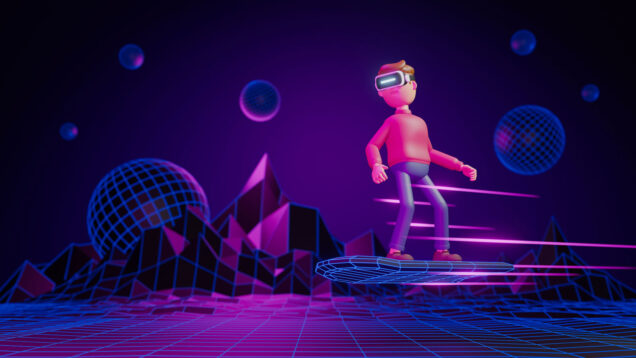

The metaverse and NFTs is considered the next evolution of the internet. What can companies learn from the new field of digital action? Imagine a virtual world in which people live, work, shop and interact with others – all from the comfort of their couch in the physical world. This is known as the metaverse. We also focus on this topic at this year’s DARWIN’S CIRCLE on November 3rd at Palais Ferstel. Get your ticket here!
 Let us introduce you one of our speakers…Kai Herzberger
Let us introduce you one of our speakers…Kai Herzberger
Kai Herzberger is heading the commerce team of Facebook for the EMEA and DACH region. He was former CMO of DailyDeal and head of marketing at BuyVIP, two startups he sold to Google respectively Amazon. His analytical background in market research gained him the leadership for the international marketing team of AOL in Dulles, VA. Kai holds a MBA of Kellogg/WHU and is co-founder of ReFuture Digital GmbH and Shops2Stay UG. He holds stakes in Falcon Agency, CineApp and other startups. Kai is empathic and drives for sustainable business growth. He created CoronaCare Winsen with his wife, a local non-profit community organization and is a founding member of the hearing community and the Cystic Fibrosis run4air organization. He is a founding member of the spam task force of eco Verband e.V.
„Metaverse“ didn’t become a household term until Facebook changed its corporate name to Meta in October 2021. At that time, the company announced plans to spend $10 billion over the next year on technologies to build out its vision of the metaverse. The metaverse is considered a next evolution of the internet. It will take many forms, including gaming, online communities and business meetings where people collaborate via a digital facsimile or avatar of themselves.
What is the metaverse?
The metaverse concept isn’t new. It was first described in the 1992 novel Snow Crash. Several companies later developed online communities based on the concept, most notably Second Life, released in 2003. In the metaverse, people use avatars to represent themselves, communicate with each other and virtually build out the community. In the metaverse, digital currency is used to buy clothes – or weapons and shielding in the case of video games – and many other items. Users can also virtually travel through the metaverse for fun with no goal in mind using a virtual reality headset and controllers. Snow Crash was more of a dystopian view of the future and didn’t put the metaverse in a positive light. Author Neal Stephenson coined the term metaverse as a kind of next-generation virtual reality-based internet. One way to achieve status in Stephenson’s metaverse was by technical skill, which was represented by the sophistication of a user’s avatar.

The metaverse concept isn’t new. It was first described in the 1992 novel Snow Crash. Several companies later developed online communities based on the concept, most notably Second Life, released in 2003. © Chaosamran_Studio
What is the difference between the internet and the metaverse?
The internet is a network of billions of computers, millions of servers and other electronic devices. Once online, internet users can communicate with each other, view and interact with websites, and buy and sell goods and services. The metaverse doesn’t compete with the internet – it builds on it. In the metaverse, users traverse a virtual world that mimics aspects of the physical world using such technologies such as virtual reality (VR), augmented reality (AR), AI, social media and digital currency. The internet is something that people „browse.“ But, to a degree, people can „live“ in the metaverse.
In the world of work, people are increasingly turning to metaverse ideas to facilitate hybrid working. At Microsoft, meetings are held in a virtual environment with the use of avatars to make digital conferences more lively. With the creation of virtual spaces in Microsoft apps users can network or work together appropriately. Before the meeting, participants are asked whether they want to activate the camera or participate as an avatar and there will be numerous customization options so that the 3D figure is also dressed appropriately. Mouth movements and gestures will be adopted as realistically as possible by the user, with artificial intelligence generating animations. This hybrid solution is only part of the „Metaverse for Business Relationships. For this increased use, Microsoft also sees the use of headsets as necessary, whether virtual or augmented reality.
The metaverse is already a reality at many corporations. The venture capitalist Matthew Ball wrote a significant essay on this, detailing the future of the Metaverse. Ball’s 2020 essay „The Metaverse: What It Is, Where to Find It, Who Will Build It, and Fortnite,“ received high praise from company leaders. While the text states that „the full vision for the Metaverse remains elusive, fantastical and decades away“, Ball nonetheless defines seven core attributes for the Metaverse in his essay, e.g. that the metaverse can never be stopped or paused and that the Metaverse as a whole takes place in real time. Furthermore, there is no upper limit for the number of participants and it has its own economy and digital objects are interchangeable.
Other companies, e.g German Railways, are using VR glasses to counter the shortage of skilled workers by leveraging the knowledge of soon-to-be-retired employees and passing it on to the next generation of employees. For some years now, German Railways has been relying on „mixed reality“ for this purpose: New employees are trained with the help of software from Teamviewer and the Hololens data glasses from Microsoft. The technology allows them to create and edit a virtual version of the turnout, extract individual parts or practice repairs. This results in better visualization, deeper understanding and helps to dovetail theory and practice more closely.
Especially in the gaming industry, VR glasses are taking on an increasingly important role. Tik Tok operator ByteDance is increasingly focusing on the production of VR glasses so that users can use the metaverse in the form of games. The Android-based Pico 4 glasses are very similar to Meta’s Quest 2 glasses.
How do NFTs fit into the metaverse?
Nonfungible tokens (NFTs) figure to play a big role in the usefulness and popularity of the metaverse. NFTs are a secure type of digital asset based on the same blockchain technology used by cryptocurrency. Instead of currency, an NFT can represent a piece of art, a song or digital real estate. An NFT gives the owner a kind of digital deed or proof of ownership that can be bought or sold in the metaverse.
Metaverse Properties bills itself as the world’s first virtual real estate company. The company acts as an agent to facilitate the purchase or rental of property or land in several metaverse virtual worlds – including Decentraland, Sandbox, Somnium and Upland. Offerings include conference and commercial spaces, art galleries, family homes and „hangout spots.“
While the metaverse has created opportunities for new companies such as Metaverse Properties to offer digital goods, established brick and mortar companies are also jumping in. For example, Nike acquired RTFKT – a startup that makes one-of-a-kind virtual sneakers and digital artifacts using NFTs, blockchain authentication and augmented reality. On its website, RTFKT said it was „born on the metaverse, and this has defined its feel to this day.“ Prior to the acquisition, Nike filed seven trademark applications to help create and sell virtual sneakers and apparel.
Be part of it! LIVE 3rd of November 2022 in Vienna
With regard to the digital conference DARWIN’S CIRCLE at 3rd of November 2022 at Palais Ferstel in the 1st district of Vienna we take great pride in the harmonious mix of attendees and speakers. Access to our events is on an invite-only basis, ans is limited to top-managers. We will discuss the most relevant topics of our time such as Artificial Intelligence (AI), the future of mobility, digital transformation, FinTech and new media next to socio-economic topics like the future of work, smart-cities, digital ethics and responsibility, sustainability and leadership.
 Let us introduce you one of our speakers…Constantin Gonzalez
Let us introduce you one of our speakers…Constantin Gonzalez
Constantin Gonzalez is a principal solutions architect at Amazon Web Services (AWS). He helps customers in Germany, Austria and Switzerland build new and innovative solutions with cloud technology. Innovation and digital transformation are all about culture and organization: therefore, he frequently talks to customers about these critical topics as well. He joined AWS in 2012 and worked with customers of all sizes and all industries since. He‘s a frequent presenter at AWS and other conferences on a variety of topics like cloud strategy, digital innovation, and machine learning.
Wir liefern die besten Stories und spannendsten Trends direkt in dein Postfach, jeden Freitag! Werde Teil der Community!